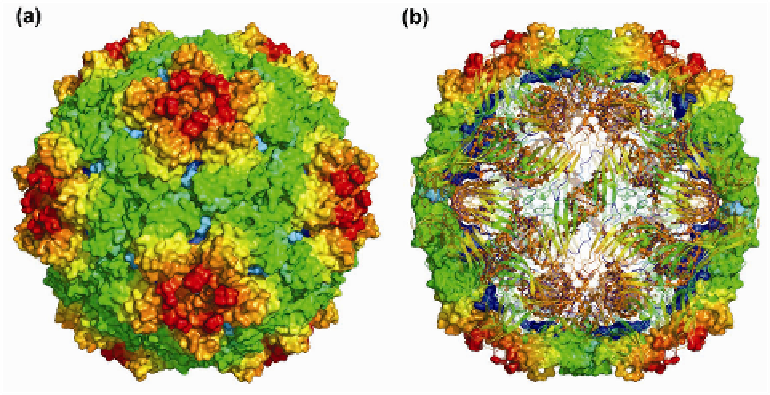Information Technology Reference
In-Depth Information
Fig. 7.7.
The structure of STMV.
(a) The structure of STMV represented by its capsid, colored by
geometric positions to illustrate the icosahedral symmetry. (b) A cross section view of the STMV,
highlighting the capsid and enclosed genetic material (RNA). The RNA, shown as cartoon
representation in yellow, on which spherical dots represents the positions of atoms P, C2 and C4'.
These atoms are used to build up the elastic network in ANM.
7.3.2.
Viruses
Viral capsids are some of the largest systems to have been studied with ENMs.
Their large size - on the order of a million atoms - places many viruses beyond
the reach of MD. Even NMA of viral ENMs is computationally cumbersome,
necessitating the use of various techniques to further simplify normal mode
calculation. The RTB method was used (Tama & Brooks, 2002; Tama &
Brooks, 2005) to investigate swelling of viral capsids, leading to the observation
that capsid maturation in several viruses can be largely accounted for with only a
few non-degenerate (icoasahedrally symmetric) slow modes. The symmetry of
viral capsids was exploited (Kim
et al.
, 2003; Kim
et al.
, 2004) to construct
simplified ENMs for studies of capsid maturation, while the maturation of the
HK97 bacteriophage was explored using the GNM (Rader
et al.
, 2005). The
dynamics of sufficiently small viruses can thus be analyzed through direct
application of an ENM without further simplification, as exemplified below.
The satellite tobacco mosaic virus
(STMV) is one of the smallest viruses known,
consisting of 60 identical protein subunits arranged in an icosahedral shell about
a single-stranded RNA with 1058 nucleotide bases (Figs. 7.7a
and
7.7b) (Dodds,
1998; Day
et al.
, 2001). Recent studies of STMV include the structural analysis

